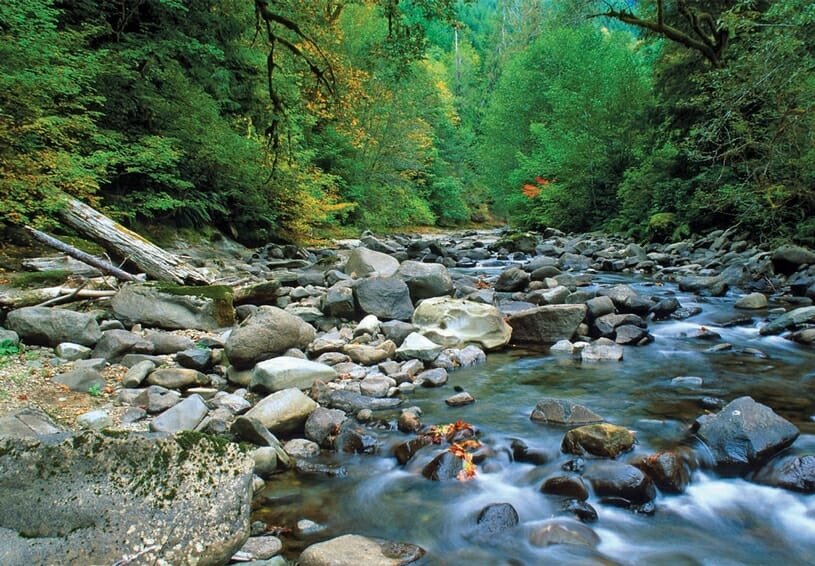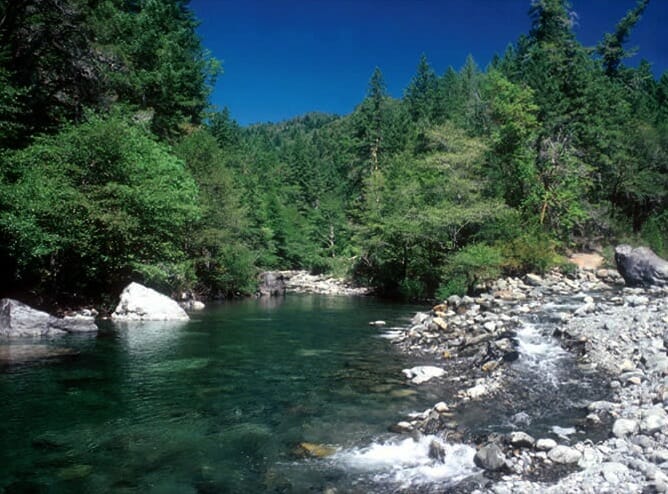The North Fork of the Smith River.
Dean Finnerty knows good steelhead water when he sees it.
Finnerty, a lifelong resident of Oregon and longtime fishing guide, says the headwaters of the fabled Smith River are “some of the best habitat for wild steelhead, anywhere.”
Indeed, the remarkably lucid green waters of the Kalmiopsis region in southwest Oregon provide highly productive habitat not only for steelhead, but also for other species of interest to anglers, including Chinook and coho salmon, resident rainbow trout, and both sea-run and resident coastal cutthroat trout. Anglers come from around the world to fish the lower Smith River.
Finnerty is northwest region director of Trout Unlimited’s Sportsmen Conservation Project and is director of TU’s Wild Steelhead Iniative. For several years he has been active in a coalition of conservation and local angling groups defending the Kalmiopsis — and in particular the headwaters of the Smith River — from proposed large scale nickel mining.
 The NF Smith River. Photo: Western Rivers Conservancy
The NF Smith River. Photo: Western Rivers Conservancy
Representative Peter DeFazio and Senator Ron Wyden have introduced legislation that would permanently protect the Smith River headwaters from hard rock mining. While Congress deliberates the Southwestern Oregon Watersheds and Salmon Protection Act, TU and other sportsmen’s groups urged the U.S Forest Service and Bureau of Land Management to issue a mineral withdrawal to ensure that no new mining claims would be developed until Congress can act on the bill. In addition, wild steelhead and angling advocates encouraged the State of Oregon to adopt new rules and designation to protect water quality, habitat and angling values in the Kalmiopsis.
These efforts paid off. In January 2017, the Bureau of Land Management extended a mineral withdrawal of 101,000 acres of federal land in the area. This withdrawal prevents development of new mining claims and was boosted from five to twenty years, to give Congress more opportunity to consider legislation that would permanently protect the region. Then, in July 2017, the Oregon Environmental Quality Commission designated the North Fork Smith River as an Outstanding Resource Waters.
The latest victory for the Smith River headwaters and its wild steelhead and salmon fisheries came on Thursday, December 7, when the Oregon Water Resources Commission adopted a new rule that reserves the surface waters of the North Fork Smith River for the specific purpose and support of “human consumption, livestock, and instream public uses including pollution abatement, fish life, wildlife, and recreation.” The Commission also limited groundwater development in the sub-basin.
These actions add another layer of protection for fish, wildlife, recreation, and water quality in a remote area that is important for downstream fisheries and the local economies they support, as well as for drinking water and other community, recreational, and agricultural purposes.
Finnerty hailed the OWRC decision as “Another major victory for fish and anglers in the headwaters of one of the finest steelhead and salmon fisheries in the Lower 48.” He added, “Like Bristol Bay in Alaska, the fish values and sustainable fishing economy of the Kalmiopsis far outweigh the potential returns of hard rock mining here.”
To read TU’s statement on the recent Oregon Water Resources Commission decision on new classification for the surface waters of the North Fork Smith River, go here.



